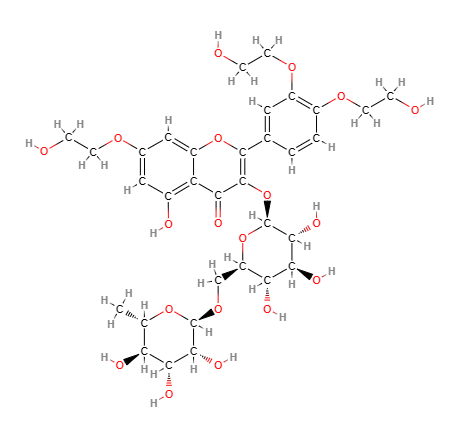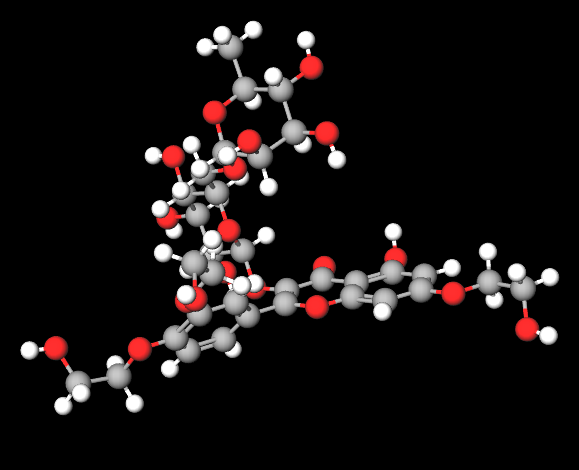| "Descrizione" by Al222 (20718 pt) | 2024-Feb-19 09:18 |
Troxerutin is a semi-synthetic derivative of rutin, a bioflavonoid found in many plants, including citrus fruits, grapes, and tea. It is primarily used for its antioxidant, anti-inflammatory, and vasoprotective properties. Troxerutin is employed in the treatment of venous disorders, such as chronic venous insufficiency, hemorrhoids, and varicose veins, and to reduce swelling and symptoms associated with these conditions.
Composition. Troxerutin is a derivative of rutin, modified to improve its solubility and bioavailability in the human body. This makes it more effective in reaching and acting on target tissues.
Chemical Industrial Synthesis Process
The production of Troxerutin, a semi-synthetic bioflavonoid derived mainly from rutin and used for its antioxidant, anti-inflammatory, and vasoprotective properties, follows a detailed process that involves both chemical synthesis and extraction from natural sources.
- Rutin Extraction. Rutin, a natural flavonoid, is extracted from plant sources such as Sophora japonica flowers or buckwheat. The extraction is carried out using solvents like ethanol or water, followed by filtration and concentration.
- Hydrolysis. The extracted rutin undergoes hydrolysis to remove sugar groups, converting it into quercetin, its aglycone. This process can be catalyzed by acids or specific enzymes.
- Troxerutin Synthesis. Quercetin is then transformed into troxerutin through a semi-synthesis process that includes the addition of hydroxyethyl groups to the molecule. This step requires specific chemical reagents and controlled reaction conditions.
- Purification. The semi-synthetic troxerutin is purified to remove impurities and reaction by-products. Purification can include techniques such as crystallization, chromatography, and filtration.
- Quality Control. The purified troxerutin undergoes quality control checks to verify its purity, chemical identity, and pharmacological properties. These checks can include spectroscopy, high-performance liquid chromatography (HPLC), and bioactivity tests.
What it is for and where
It is used in the form of gel, cream, or tablets for the topical and systemic treatment of venous disorders. It is also used in some dietary supplements for its antioxidant properties.
Medical
Antioxidant Properties. It combats oxidative stress by neutralizing free radicals, thereby protecting cells and tissues from damage (1).
Anti-inflammatory Effect. It reduces inflammation by modulating the activity of inflammatory mediators, which is particularly useful in treating venous conditions and in liver protection (2)
Vascular Protection. It improves vascular health by increasing venous tone and reducing capillary (3) permeability, which helps to prevent edema and promotes blood circulation.
Safety
Troxerutin is generally well tolerated, with minor side effects. However, as with any supplement or medication, it is advisable to consult a healthcare professional before use, especially during pregnancy or breastfeeding.
Cosmetics - INCI Functions
Skin conditioning agent. It is the mainstay of topical skin treatment as it has the function of restoring, increasing or improving skin tolerance to external factors, including melanocyte tolerance. The most important function of the conditioning agent is to prevent skin dehydration, but the subject is rather complex and involves emollients and humectants that can be added in the formulation.
CAS 7085-55-4 31511-30-5
EC number 230-389-4 250-670-5
 |  |
Molecular Formula C33H42O19
Molecular Weight 742.7 g/mol
CAS 7085-55-4
UNII 7Y4N11PXO8
EC Number 230-389-4
DTXSID4045929
Nikkaji J9.645H
Synonyms
- Trihydroxyethylrutin
- Posorutin
- Troxerutine
References_____________________________________________________________________
(1) Lim KM, An S, Lee OK, Lee MJ, Lee JP, Lee KS, Lee GT, Lee KK, Bae S. Analysis of changes in microRNA expression profiles in response to the troxerutin-mediated antioxidant effect in human dermal papilla cells. Mol Med Rep. 2015 Aug;12(2):2650-60. doi: 10.3892/mmr.2015.3717.
Abstract. Dermal papilla (DP) cells function as important regulators of the hair growth cycle. The loss of these cells is a primary cause of diseases characterized by hair loss, including alopecia, and evidence has revealed significantly increased levels of reactive oxygen species (ROS) in hair tissue and DP cells in the balding population. In the present study, troxerutin, a flavonoid derivative of rutin, was demonstrated to have a protective effect against H2O2-mediated cellular damage in human DP (HDP) cells. Biochemical assays revealed that pretreatment with troxerutin exerted a protective effect against H2O2-induced loss of cell viability and H2O2-induced cell death. Further experiments confirmed that troxerutin inhibited the H2O2-induced production of ROS and upregulation of senescence-associated β-galactosidase activity. Using microRNA (miRNA) microarrays, the present study identified 24 miRNAs, which were differentially expressed in the troxerutin-pretreated, H2O2-treated HDP cells. Subsequent prediction using bioinformatics analysis revealed that the altered miRNAs were functionally involved in several cell signaling pathways, including the mitogen-activated protein kinase and WNT pathways. Overall, these results indicated that ROS-mediated cellular damage was inhibited by troxerutin and suggested that the use of troxerutin may be an effective approach in the treatment of alopecia.
(2) Shan Q, Zhuang J, Zheng G, Zhang Z, Zhang Y, Lu J, Zheng Y. Troxerutin Reduces Kidney Damage against BDE-47-Induced Apoptosis via Inhibiting NOX2 Activity and Increasing Nrf2 Activity. Oxid Med Cell Longev. 2017;2017:6034692. doi: 10.1155/2017/6034692. Epub 2017 Oct 15. PMID: 29163754; PMCID: PMC5661100.
Abstract. 2,2,4,4-Tetrabromodiphenyl ether (BDE-47), one of the persistent organic pollutants, seriously influences the quality of life; however, its pathological mechanism remains unclear. Troxerutin is a flavonoid with pharmacological activity of antioxidation and anti-inflammation. In the present study, we investigated troxerutin against BDE-47-induced kidney cell apoptosis and explored the underlying mechanism. The results show that troxerutin reduced renal cell apoptosis and urinary protein secretion in BDE-47-treated mice. Western blot analysis shows that troxerutin supplement enhanced the ratio of Bcl-2/Bax; inhibited the release of cytochrome c from mitochondria, the activation of procaspase-9 and procaspase-3, and the cleavage of PARP; and reduced FAS, FASL, and caspase-8 levels induced by BDE-47. In addition, troxerutin decreased the production of reactive oxygen species (ROS) and increased the activities of antioxidative enzymes. Furthermore, troxerutin blunted Nrf2 ubiquitylation, enhanced the activity of Nrf2, decreased the activity of NOX2, and ameliorated kidney oxidant status of BDE-47-treated mice. Together, these results confirm that troxerutin could alleviate the cytotoxicity of BDE-47 through antioxidation and antiapoptosis, which suggests that its protective mechanism is involved in the inhibition of apoptosis via suppressing NOX2 activity and increasing Nrf2 signaling pathway.
(3) Casili G, Lanza M, Campolo M, Messina S, Scuderi S, Ardizzone A, Filippone A, Paterniti I, Cuzzocrea S, Esposito E. Therapeutic potential of flavonoids in the treatment of chronic venous insufficiency. Vascul Pharmacol. 2021 Apr;137:106825. doi: 10.1016/j.vph.2020.106825.
Abstract. Chronic venous insufficiency (CVI) is a common disorder associated with a variety of symptoms in later disease stages; despite the high prevalence of this pathology, suitable pharmaceutical therapies have not been explored to date. In this context, it was recently reported that a chronic increase in venous wall stress or biomechanical stretch is sufficient to cause development of varicose veins. Recent evidence demonstrate that flavonoids are natural substances that convey the circulatory system functionality, playing a key role in blood flow. Particularly, troxerutin, diosmin and horse chestnut extract, appear protective for the management of vascular diseases. The aim of the present study was to evaluate the effect of a flavonoid compound, containing troxerutin, diosmin and horse chestnut extract on in vitro model on HUVECs cells, due to its production of vasculoregulatory and vasculotropic molecules, on an ex-vivo model on mesenteric vessel contraction, to regularize mesenteric microcirculation and on in vivo model of CVI-induced by saphene vein ligation. Furthermore, the flavonoid compound capacity of extensibility and compatibility with peripheral veins was investigated through a tissue block culture study. The degree of absorption, the contractile venous activity, the histological analysis, the immunoistochemical and immunofluorescence evaluation for VEGF and CD34 were performed, together with inflammatory mediators dosage. For the first time, this research revealed the therapeutic potential of a compound, enriched with flavonoids, to be a supportive treatment, suitable to reduce varicose vein pathophysiology and to regularize venous tone.
| Evaluate |

